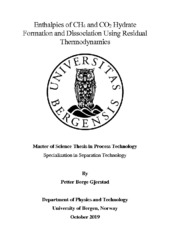Enthalpies of CH4 and CO2 Hydrate Formation and Dissociation Using Residual Thermodynamics
Master thesis
Permanent lenke
https://hdl.handle.net/1956/21034Utgivelsesdato
2019-11-27Metadata
Vis full innførselSamlinger
- Master theses [163]
Sammendrag
The problem in the processing industries regarding the formation of gas hydrate in pipelines or equipment have inspired much of the research for better understanding of hydrates. The world’s increasing demands for more energy opens for hydrate as a potential energy source. For the duration of the last few years, there have been ideas involving using hydrate, since it is a solid phase, as a better transport of gases such as methane (CH4). Carbon capture involving storage of carbon dioxide (CO2) as hydrate in empty reservoirs would help lower the greenhouse gas emission. This requires better knowledge and technology within the hydrate field, but the theory of hydrates among scientists is not necessarily in agreement. Even though hydrate was discovered in the 1800s, any precise method of determining the heat of hydrate formation or dissociation is widely spread. The equilibrium pressure and temperature for hydrates are well known and in good agreement among scientists. The approaches of measuring or calculating the enthalpy changes of hydrate phase transition are implemented by using experiments, the Clapeyron equation or the Clausius-Clapeyron equation. The deficiency of information or the estimation of hydration numbers makes the experimental results challenging to trust or rely on. Clausius-Clapeyron equation, which is a simplified version of the Clapeyron equation, is very popular for calculating the heat of hydrate dissociation but is inaccurate at higher pressures compared to the Clapeyron equation. The Clapeyron approach relies on equilibrium conditions, and since hydrates cannot reach equilibrium in real life, approaches that can calculate for non-equilibrium systems would be a better choice. Since the enthalpy change is directly coupled to the change in free-energy, by calculating the change in free-energy of the phase change, we can directly calculate the heat of hydrate formation and dissociation using residual thermodynamics. The method of using residual thermodynamics for hydrate calculation is proposed in this work and is not limited to heterogeneous hydrate formation from liquid water and hydrate phase, but can be used to calculate for homogeneous hydrate formation from dissolved hydrate formers in liquid water also. In this work, the enthalpy of hydrate formation for both CH4 and CO2 hydrates along with hydration numbers have been calculated using residual thermodynamics at equilibrium conditions from temperatures of 273.16 K to 290.0 K. These values have also been compared with other works recorded in literature based on experimental works, Clapeyron equation and Clausius-Clapeyron equation.
